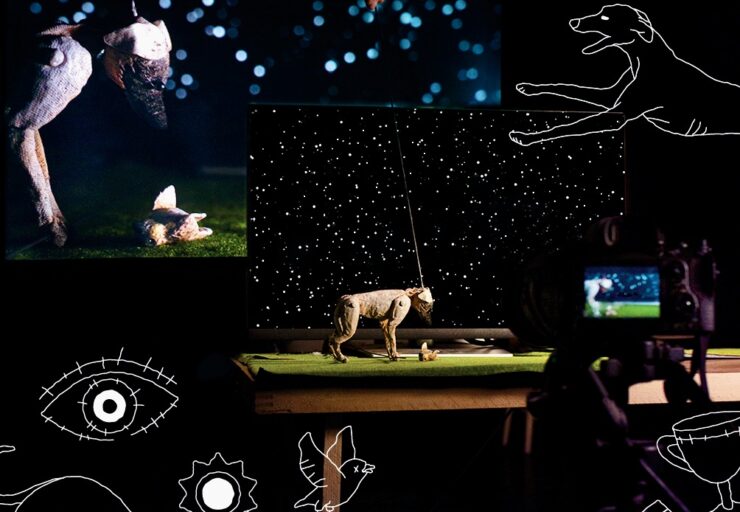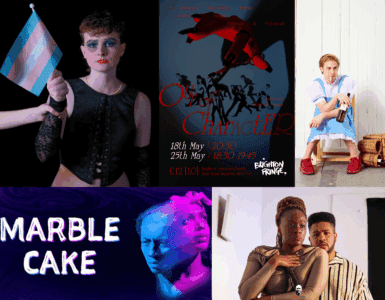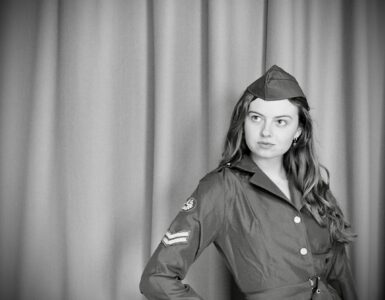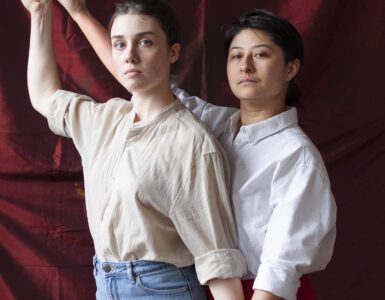A stage lined with puppets and dioramas. Astroturf underneath a keyboard. A large projector. And a sold-out show with an audience not quite sure of anything, with one exception: How can you say no to that puppy-dog face?
Bark Bark is advertised as live puppetry cinema that explores the connection between the human and non-human world. It’s fortuitous that we are sat in the Anatomy Lecture Theatre at Summerhall. We are a very human audience inhibiting a space created for the wellbeing and care of animals. It is not so distant from the world of the play: a house belonging to a retired veterinarian and Crufts trainer.
The story opens with rain hammering down on wet earth as storms simmer in the background. The scene of a crime: a dead garden bird put to rest on a torn-up lawn while a couple settle in to their first dog-sitting experience. In the first few moments of the show a felt beady-eyed greyhound stares down at his handy work and the camera pans up to the strings and wires of the puppeteers. There is an acceptance here, or rather an invitation, to see the masters at work, as much a part of the play as the cinema projected on screen. It resembles sitting in a Sushi bar or Pizza Express – sending secret glances towards the chefs, hungrily awaiting what they’ve committed to serve.
It is curious story, with an even more curious protagonist. It’s partly whodunnit and partly an exploration of the life we’ve lived and will go on to live. Bark Bark seems to ask the question: what happens when our life doesn’t fit us anymore and we outgrow what we know?
Dioramas transport us through three zones; the neatly curated flat, the great outdoors and the close-up counter tops and patches of earth. The strongest moments involved the simplest set and puppetry mechanics. The joy of seeing two tubular rigid felt dog legs plopping into view and “digging” up a dead bird enraptures the audience and the skilful timing of the camera crew and puppeteers (Beckett Grey and Eliz Avni) injects life into still objects.
The dog-sitting couple, Laura (Camilla Anvar) and Peter (Alistair Hendry), slip seamlessly between their physical selves and puppet miniatures. They are unified by their matching outfits, converse shoes and nervous energy. It works well because we view this story through the perspective of the dog. Shots are framed just below the kneecaps and human voices float separate and unworldly. We watch the world like Snoopy in a Peanuts cartoon, but without having to suffer the untranslatable language barrier.
“It”, a little whippet or greyhound-esque dog, is the star of the show. The dog’s big shiny black eyes try earnestly to make sense of the complicated world around it. A changing and ever terrifying world at that, full of new smells, new company and new revelations.
One of the most remarkable aspects of the set design is their ability to create depth and pace in their forest scenes. In these moments, the cinema feels most alive. The greyhound does what it does best, running hard and fast against the night air and we watch in awe as trees speed away behind it. Nose pointing directly at its target while panting, exasperated dogsitters follow up behind.
Moments like these, where the dog puppet truly comes alive, are the most joyous. Its ears pricking up in anticipation, its tail wagging with a bounding energy, and its paws locked in a playful dance with a neighbouring fox.
Home is also a common theme in the piece, as we follow the couple learning to get comfy in place unbecoming them. They try to find their feet in an uncertain future and wonder whether the place they go home to is destined to be home much longer.
A standout aspect of the show is the live pianist, Faye James, who pulls us back into the space of early silent movies and brings forth that feeling of possible change. Unlike cinema, nothing is quite locked down in theatre and that is true for this live animation. The piano reminds us that we are in the present. The music expresses the feelings of the dog and in doing so shares the hope and curiosity for some unknown, better future. Bark Bark stares into the future continually and questions how we step into the undetermined from an unsettled past. What choices do we make? How do we listen to each other? How do we fight? What battles do we chose to win?
There were a few technical issues which are hard to avoid in such an ambitious production. The cast had to live-mix countless, changing dioramas and cameras, all the while running between minute sets packed into an equally minute room. The odd fault was bound to happen: a fallen fence, occasional mic feedback and unfocused cameras. The audience took this on the chin as the charm of such a spectacle washed away any sense of being pulled from the immersion. This is another reason that highlighting the puppet wires at the start of the piece was so effective.
Buzzcut Productions do an excellent job in colliding nature with our human lives. The story invites a stream of visitors; foxes and an entire murmuration of starlings that have to co-exist with car headlights, whitewashed fences and disturbing taxidermies. This intruding couple must find peace in the space as the days pass and the dog fights against an oncoming feeling of terror. The production goes beyond exploring how we experience nature and connection. It pushes to define how we preserve those experiences.
There is a wholesomeness to the creativity at play. A broken accordion is transformed into the dog’s uneasy breaths, and real hands hold delicately onto a bird made from plastic feathers and polystyrene. We follow the dog between the waking and dreaming world in a similar way to how we shift between the world of the story and the world of the artist. As Peter says in the piece’s beginning moments; “it’s nice to be in the real world for a bit.” And it’s nice to pull back the curtain on puppetry and film – to be part of the magic as its happening; live and in the room. Bark Bark is tremendously delightful, filled with joyous surprises and heartfelt humour. It plucks everyday experiences and sets them into a frame of cinematic art. Something we could all take a moment to do.
Recommended drink: A pint of malty paw-ter.
You can catch Bark Bark between 1-11th, 13-18th, 20-26th August at 12:00 at Summerhall Anatomy Lecture Theatre. You can book tickets through the EdFringe Box Office.
Hear the latest from Marginalised Voices from Fringes across the World
Subscribe to our Email Newsletter so we can send you insightful updates about unheard creative voices working to platform powerful stories. You'll be the first to hear about our content and how to apply to have shows you're working on reviewed.
Powered by EmailOctopus









